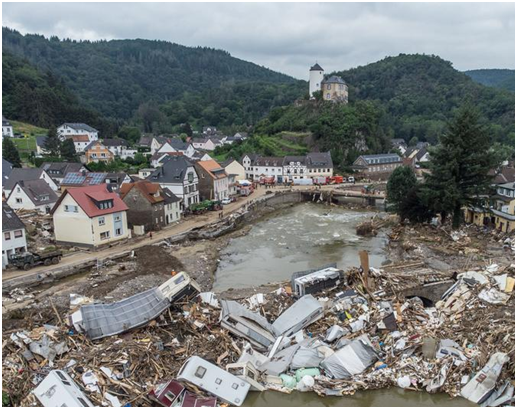This paper analyses science diplomacy efforts to reduce disaster risks and proposes establishing national knowledge exchange centers (KECs) to help individual states adhere to their Sendai Framework goals.
More“Science diplomacy for disaster risk reduction”Natural hazards and climate change are not drivers of disasters
Many countries face challenges in assessing, understanding, and responding to time-dependent disaster risks. The increasing intensity of extreme events, combined with the increasing vulnerability of people and infrastructure to natural hazards such as earthquakes and tsunamis, volcanic eruptions and lava flows, floods and hurricanes, are changing the impact of natural hazards on society in a largely negative way. A.Ismail-Zadeh’s article “Natural hazards and climate change are not drivers of disasters” published in Natural Hazards examines the relationship between natural hazard events, climate change, social and physical vulnerabilities, and decision-making. While natural hazards provoke disasters and climate change increases the frequency and magnitude of events, vulnerability and exposure to natural hazards are major drivers of disasters. Informed decision-making to reduce disaster risk must be based on scientific evidence about natural hazards and climate change, knowledge about vulnerabilities, and various scenarios for disaster prevention in disaster preparedness. Doug Bostrom and Mark Kodack (Bostrom and Kodack, 2021) wrote about this paper: “One of the more thought-provoking articles in this week’s collection … A provocative title, but it’s hard to argue with the article’s premise … Dr. Ismail-Zadeh points out that when we’re fully informed of risks and hazards, disasters mostly happen only when we ignore that information and fail to take it into account in our systems of communicating and living … The author examines some case histories of hazards and risks inadequately folded into plans and actions, and points out specific means to redress the situation.”
A. Ismail-Zadeh mentions in a note “Poor planning compounded European flooding catastrophes” published in Nature that the catastrophic consequences of the 2021 floods in Germany (Figure 1) and neighboring countries were exacerbated by a lack of preparation and public awareness. Climate change, referred to by many in connection with disasters, can cause an increase in the number and power of extreme hydro-meteorological events, so, for example, frequent heavy rains can lead to floods. But to say that climate change is responsible for disasters caused by flooding is akin to saying that the SARS-CoV-2 virus is fueling the COVID-19 pandemic and its socio-economic consequences. The virus triggered the pandemic, but its spread was facilitated by many countries’ lack of preparedness and delayed control measures. “Countries must urgently take steps to mitigate the risks associated with extreme flooding and other natural and human-induced hazard events, if future damage is to be averted,” writes A. Ismail-Zadeh.

The study was supported by a grant from the Russian Science Foundation (19-17-00027).
Ismail-Zadeh, A. (2021) Natural hazards and climate change are not drivers of disasters. Natural Hazards. DOI: 10.1007/s11069-021-05100-1
Ismail-Zadeh, A. (2021) Poor planning compounded European flooding catastrophes. Nature, 598(7879), 32. DOI: d41586-021-02712-2
Bostrom, D., and Kodack, M. (2021) Skeptical science new research for week #45. Available at: link.
Models of lava dome growth at Volcán de Colima in Mexico
Magma extrusion, lava dome growth, dome collapse, and associated pyroclastic flow hazards are among the important volcanological studies. Volcán de Colima is one of the most active volcanoes in North America. It is located in the western part of the Trans-Mexican volcanic belt at 3,860 m.
More“Models of lava dome growth at Volcán de Colima in Mexico”
Rotational Seismology: Review of Achievements and Outlooks
Rotational seismology is a relatively new area of science. Rotational movements can be caused by earthquakes, explosions or other causes. Rotational seismology could be applied in a wide range of seismology disciplines, including strong-motion and broadband seismology, earthquake engineering, earthquake physics, seismic instrumentation, and seismic hazards. The figure shows how the various phases of an earthquake can be easily determined by using rotational sensors. Of particular interest are the anomalously large rotational movements recorded in the near zone.
More“Rotational Seismology: Review of Achievements and Outlooks”
Robust phase algorithms for estimating apparent slowness vectors of seismic waves from regional events
The problem of estimating the apparent slowness vector of a plane P-wave generated by a regional seismic event from observations of a small-aperture seismic array is considered in the paper written by A.V. Varypaev and A.F. Kushnir. The case is considered when array sensors are affected by strong non-stationary and non-Gaussian random noise.
More“Robust phase algorithms for estimating apparent slowness vectors of seismic waves from regional events”Technique of local probabilistic tsunami zonation for near field seismic sources applied to the Bechevinskaya Cove (the Kamchatka Peninsula)
The article “Technique of local probabilistic tsunami zonation for near field seismic sources applied to the Bechevinskaya Cove (the Kamchatka Peninsula)”, co-author is A.V. Lander, was published in the journal Natural Hazard (Q2 WoS).
The study was carried out by the staff of IEPT RAS (synthetic catalog of earthquakes), ICT SB RAS (calculation of the heights of tsunamis), IVS FEB RAS (field observations).
More“Technique of local probabilistic tsunami zonation for near field seismic sources applied to the Bechevinskaya Cove (the Kamchatka Peninsula)”Inverse scattering – Fourier analysis – super-resolution
The paper “Stability estimates for reconstruction from the Fourier transform on the ball” was published in “Journal of Inverse and Ill-Posed Problems” (Q1 WoS) journal. Doctor of physical and mathematical sciences Novikov R.G. is one of the authors of this article.
More“Inverse scattering – Fourier analysis – super-resolution”
